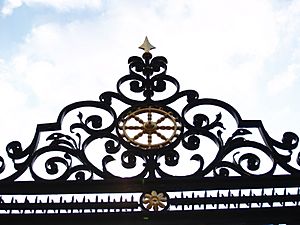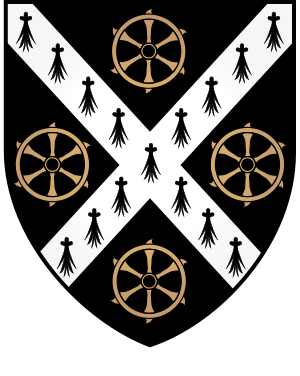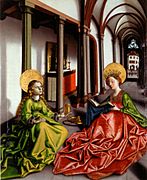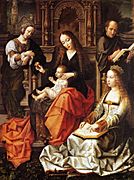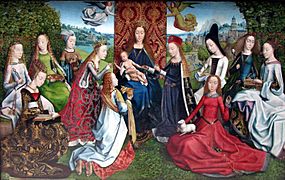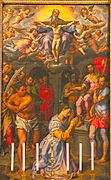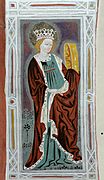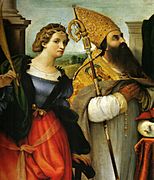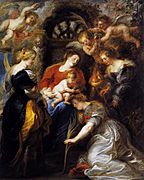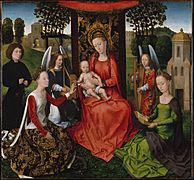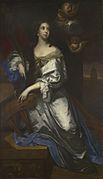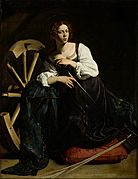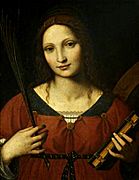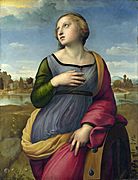Catherine of Alexandria facts for kids
Quick facts for kids SaintCatherine of Alexandria |
|
|---|---|
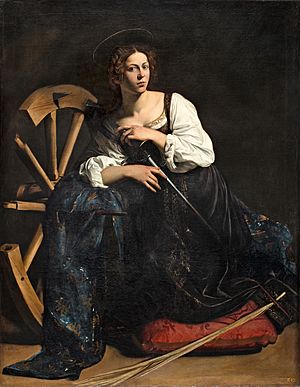
Caravaggio, Saint Catherine of Alexandria, 1598–99, Thyssen-Bornemisza Museum
|
|
| Virgin and martyr | |
| Born | c. 287 Alexandria, Roman Egypt |
| Died | c. 305 (aged 17–18) Alexandria, Roman Egypt |
| Venerated in | Catholic Church Eastern Orthodox Church Oriental Orthodox Churches Anglican Communion Lutheranism |
| Canonized | Pre-Congregation |
| Major shrine | Saint Catherine's Monastery |
| Feast |
|
| Attributes | breaking wheel; sword; with a crown at her feet; hailstones; bridal veil and ring; dove; surrounded by angels, scourge; book; woman arguing with pagan philosophers |
| Patronage | Unmarried girls; apologists; craftsmen who work with a wheel (potters, spinners); archivists; dying people; educators; girls; jurists; knife sharpeners; lawyers; librarians; libraries; Balliol College; Massey College; maidens; mechanics; millers; milliners; nurses; philosophers; preachers; scholars; schoolchildren; scribes; secretaries; spinsters; stenographers; students; tanners; theologians; St. Catherine University; University of Oviedo; University of Paris; haberdashers; wheelwrights; Santa Catarina (state), Brazil; Aalsum, Germany; Żejtun, Malta; Żurrieq, Malta; Katerini, Greece; Grude, Bosnia and Herzegovina; Pagbilao, Quezon, Philippines; Gerona, Tarlac, Carcar, Cebu, Porac, Pampanga, Arayat, Pampanga, Dumaguete, Santa Catalina, Negros Oriental, Santa Catalina, Ilocos Sur, Santa, Ilocos Sur, Leon, Iloilo, Tayum, Abra, Diocese of Dumaguete, Negros Oriental, University of Santo Tomas; Bagac, Bataan. |
Catherine of Alexandria (also called Katherine) is a Christian saint and virgin. People believe she was killed for her faith in the early 300s by Emperor Maxentius. Stories say she was a princess and a very smart scholar. She became a Christian around age 14 and helped many others convert. She was killed when she was about 18 years old. Over 1,100 years later, Joan of Arc said that Saint Catherine was one of the saints who spoke to her and gave her advice.
The Eastern Orthodox Church honors her as a Great Martyr. They celebrate her feast day on November 24 or 25. In Catholicism, Catherine is one of the Fourteen Holy Helpers. Her feast day is November 25. It was removed from the main calendar in 1969 but brought back in 2002 as an optional day to remember her.
Some modern experts think Catherine's story might be based on the lives of other women. These include Saint Dorothea of Alexandria and the Greek philosopher Hypatia. However, the Catholic Encyclopedia says that even if the stories have changed over time, it does not mean Catherine herself never existed.
Contents
Catherine's Story
According to old stories, Catherine was the daughter of Constus, a governor in Alexandria. This was during the time of Emperor Maximian (286–305). From a young age, Catherine loved to study. She had a vision of the Virgin Mary and the Child Jesus. This vision convinced her to become a Christian.
When Emperor Maxentius started to persecute Christians, Catherine bravely went to him. She told him that his actions were cruel. The emperor then called 50 of the best pagan philosophers and speakers to argue with her. He hoped they would prove her Christian beliefs wrong. But Catherine was very smart and won the debate. Many of her opponents were so impressed by her words that they became Christians themselves. They were then immediately put to death.
Honoring Saint Catherine
In the 500s, the Eastern Emperor Justinian built what is now Saint Catherine's Monastery in Egypt. This monastery was built around the spot where Moses supposedly saw the burning bush. Many people visit the Monastery hoping for healing.
Is the Story True?

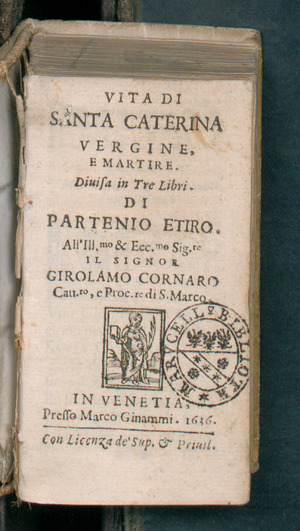
The Catholic Encyclopedia says that while Catherine might have been a real person, many of the detailed stories about her are likely later additions. The Encyclopædia Britannica notes that there are no written records of Catherine before the 800s. This makes her story's truthfulness uncertain.
Some historians, like Donald Attwater, believe that Catherine's story is a legend. They think it might have been created by a Greek writer to inspire people. Harold Davis also states that researchers have not found any historical person who matches Catherine's story.
Anna Brownell Jameson was the first to suggest that Catherine's life might have been mixed up with Hypatia of Alexandria. Hypatia was a Greek mathematician and philosopher who lived later. She was killed by a Christian group. The idea that Catherine's story is based on Hypatia's life is a popular theory among modern scholars. However, Christine Walsh says there is no clear proof for or against this idea.
Another possible inspiration for Catherine's story is a young Christian woman mentioned by the writer Eusebius. Around the year 320, Eusebius wrote that Emperor Maximinus wanted a young Christian woman to be his mistress. When she refused, he punished her by sending her away and taking her property. Eusebius did not name this woman.
The oldest full story of Catherine's life appeared around 600 years after she supposedly died. This was in a document called the Menologium in the late 900s. However, her relics (remains) were supposedly found at Saint Catherine's Monastery around the year 800. This suggests people were already honoring her at that time.
What Her Name Means
Her name in Greek is Aikaterínē or Hekaterínē. The exact meaning is debated. It could come from a Greek word meaning "each of two" or be linked to the goddess Hecate. It might also relate to a Greek word for "suffering" or a Coptic name meaning "my consecration of your name." In early Christian times, her name became linked to the Greek word katharós, meaning "pure." Because of this, the Latin spelling changed from Katerina to Katharina.
Some stories say her first name was Dorothea. When she was baptized, she received the name Aikaterina. This name was said to mean "pure, clean, and uncontaminated."
Her Popularity in the Middle Ages
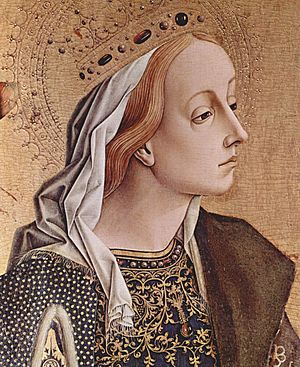
Catherine was one of the most important saints in the late Middle Ages. She was seen as the most important of the virgin martyrs. These were saints like Agnes of Rome and Margaret of Antioch. People believed she had great power to help them through prayer. In her stories, she asks Christ to answer the prayers of those who remember her death and call on her name.
Her popularity grew after her body was supposedly found around the year 800 at Mount Sinai. People claimed her hair was still growing, and a healing oil flowed from her body. Many people made pilgrimages to Mount Sinai to visit her shrine. Famous travelers like John Mandeville wrote about their journeys there.
While Mount Sinai was the most famous place to visit, it was also hard to reach. In the West, a monastery in Rouen claimed to have Catherine's fingers. Other shrines were found in places like Canterbury and Westminster. These places claimed to have a small bottle of her oil, brought back from Mount Sinai.
St. Catharine's College, Cambridge was founded on her feast day, November 25, in 1473. It was named after her because she was a patron saint of learning.
St Catherine's College, Oxford also developed from a group for students in 1868.
Catherine was also very popular among women. She was seen as a role model for proper behavior, especially for young women. Writers like Christine de Pizan used Catherine as an example of virginity and purity for young women. From the early 1300s, stories and art showed the "mystic marriage" of Saint Catherine. This is where she is shown marrying the Infant Christ. Her popularity in the Western church began to decrease in the 1700s.
Honoring Her Today
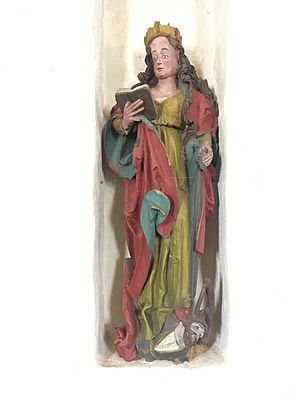
Her main symbol is the spiked wheel, which is now called the Catherine wheel. Most Christian churches celebrate her feast day on November 25. However, some Eastern Orthodox Churches, like the Russian and Serbian ones, celebrate it on November 24. The reason for this difference is not fully known.
The 1908 Catholic Encyclopedia described her importance:
She was seen as one of the fourteen most helpful saints in heaven. Preachers often praised her, and poets wrote about her. It is believed that Jacques-Benigne Bossuet wrote a beautiful speech about her. Adam of St. Victor also wrote a wonderful poem in her honor.
In many places, her feast day was a very important celebration. People would stop working, and many would attend church services. In some parts of France, it was a Holy Day of Obligation until the early 1600s. Many chapels were named after her, and most churches had a statue of her. These statues usually showed her with a wheel, which was the tool used in her torture.
Traditions and Customs
In France, unmarried women who turned 25 were called "catherinettes." On her feast day, they would wear special, fancy hats. This tradition led to a French saying, coiffer Sainte-Catherine, meaning "to don St. Catherine's bonnet." It describes an unmarried woman between 25 and 30 years old.
To remember her sacrifice, some homes in Egypt and the Middle East offer special foods on her feast day. These include hummus or tabbouleh salads. People also enjoy melons cut into circles or cookies shaped like spiked wheels with icing.
Nicholas of Myra was seen as the patron saint of young single men and students. Similarly, Catherine became the patroness of young single women and female students. She was considered one of the holiest and most famous virgins after the Blessed Virgin Mary. Because of this, she was thought to be worthy of watching over young women.
Since the spiked wheel became her symbol, wheelwrights and mechanics placed themselves under her protection. Also, because she was said to have won debates against smart sophists, she became the patron saint of theologians, apologists, speakers, and philosophers. Before studying or writing, they would ask her to help them think clearly and speak well. This devotion to Catherine grew greatly in Europe after the Crusades. It became even more popular in France in the 1400s when it was rumored that she had spoken to Joan of Arc. She was said to be Joan's divine adviser, along with Margaret of Antioch.
Devotion to Catherine is still strong among Eastern Catholics and Eastern Orthodox Christians. With easier travel today, more people are making pilgrimages to Saint Catherine's Monastery on Mount Sinai.
The Church of England remembers Catherine of Alexandria with a commemoration on November 25. In 2022, Catherine was officially added to the Episcopal Church liturgical calendar. She shares a feast day with Barbara of Nicomedia and Margaret of Antioch on November 24.
Her Legacy

The Catherine wheel firework, which spins with sparks, is named after the saint's torture wheel.
The lunar impact crater Catharina on the Moon is named after Saint Catherine.
Santa Catarina Island in Brazil and the State of Santa Catarina are also named after her.
The Gulf of Santa Catalina in the Pacific Ocean is named after her. Santa Catalina Island off California was named by Sebastián Vizcaíno. He arrived there on her feast day. The Santa Catalina Mountains in Arizona also bear her name.
Kaarina, Finland, is named after her. One idea for the name of St. Catharines, Ontario, is Saint Catherine of Alexandria. However, there is no clear proof for this.
St. Catherine University in St. Paul, Minnesota, was founded in 1905 and named for St. Catherine of Alexandria. University of Saint Katherine in San Marcos, California, is the first Eastern Orthodox Christian university in the United States. St. Catherine's School is an Episcopal school in Richmond, Virginia. St Helen and St Katharine, a girls' school in Oxfordshire, England, celebrates "St. Katharine's Day" every November. The name of St. Catharine's School for Girls (Kwun Tong) in Hong Kong was chosen because it sounds good in Chinese.
St Catherine of Alexandria Parish and School in Oak Lawn, Illinois, USA, is also named after St. Catherine.
In Art
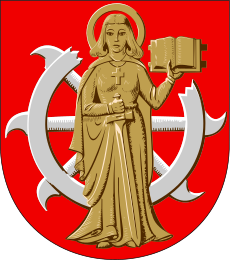
Many artworks show Saint Catherine, especially from the Middle Ages. This was also when the story of Saint Catherine's Mystical Marriage first appeared in writings. You can usually recognize her easily. She is often dressed richly and wears a crown, showing she was a princess. She often holds or stands next to a piece of her wheel, which is her symbol. She also often carries a martyr's palm or the sword used to execute her. She often has long, loose blonde or reddish hair because she was unmarried.
Paintings of the vision of Saint Catherine of Alexandria usually show the Infant Christ, held by the Virgin Mary, placing a ring on her finger. This follows some written stories. However, in the Golden Legend, he appears as an adult, and the marriage happens with many angels and heavenly beings.
She is often shown with the Virgin and Child. She is also prominent in scenes called Master of the Virgo inter Virgines, which show a group of virgin saints around the Virgin and Child. Famous later paintings of Catherine include single figures by Raphael and Caravaggio.
-
Ambrogio Bergognone. The Mystic Marriage of Saint Catherine of Alexandria and Saint Catherine of Siena
-
Konrad Witz, Saints Mary Magdalen and Catherine, shown as a crowned scholar with her wheel behind
-
Girolamo Citolanzo, The Martyrdom of St. Catherine, Basilica of Santa Maria Maggiore, Rome
-
The Resurrection of the Body of St. Catherine, Refectory Museum of the Cathedral of St. Mary, Pamplona, Spain
-
Lorenzo Lotto, Catherine of Alexandria and Saint Augustine
-
The Crowning of Saint Catherine, by Peter Paul Rubens
-
Mystic Marriage of Saint Catherin' (triptych by Hans Memling
-
Catherine of Braganza, Queen of England, painted as Catherine of Alexandria - by Jacob Huysmans
-
Fillide Melandroni as Catherine of Alexandria - by Caravaggio
-
Bernardino Luini - Painting of Catherine of Alexandria, (National Art Museum of Azerbaijan)
-
Saint Catherine of Alexandria by Raphael
In Music and Media
- Adest dies triumphalis is a song in 9 voices honoring Saint Catherine by Francisco Valls.
- The Catherine Wheel is a music album by David Byrne. It was created for a dance project.
Contemporary Media
- In an episode of the TV show The Sopranos called "Amour Fou", characters discuss a painting of The Mystical Marriage of Saint Catherine of Alexandria.
- A movie about Catherine, titled Decline of an Empire, was made in 2014.
See also
 In Spanish: Catalina de Alejandría para niños
In Spanish: Catalina de Alejandría para niños
- Cathedral of St. Catherine, Old Goa
- List of Christian women of the patristic age
- Saint Catherine of Alexandria, patron saint archive
- St. Catherine of Boletice
- St. Catherine's Cathedral, Kherson, dedicated to Saint Catherine. The city of Kherson was originally named "to the Glory of Catherine."
- St. Catherine's Day
- St. Catherine's taffy


